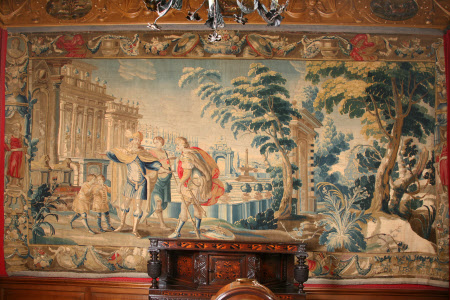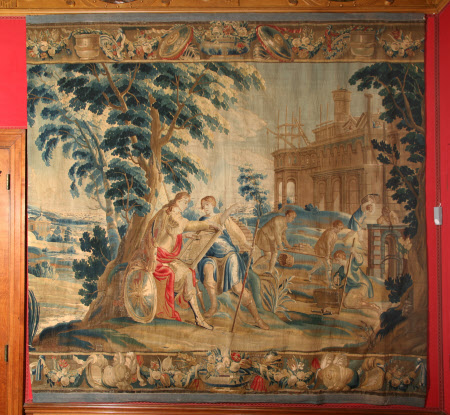The Story of Cadmus
possibly Michel Wauters (d.1679)
Category
Tapestries
Date
circa 1675 - circa 1700
Materials
Tapestry, wool and silk, 6 warps per cm
Place of origin
Antwerp
Order this imageCollection
Lyme, Cheshire
NT 500317
Summary
A set of three tapestries of the Story of Cadmus, tapestry, wool and silk, 6 warps per cm, probably Michiel Wauters or Wauters, Cockx and de Wael, Antwerp, c. 1675 – 1700.
Full description
The three tapestries at Lyme are part of a larger series of designs telling the story of Prince Cadmus, the son of Agenor, King of Tyre in Phoenicia. Cadmus was the founder of the city of Thebes, and is credited with bringing the Phoenician alphabet to Greece; he was also the grandfather of Actaeon. He is mentioned in various Greek sources including the ‘Histories’ of Herodotus, but the source for the tapestry series is Ovid’s ‘Metamorphoses’. The subject of the first tapestry in the series is the abduction of Europa, Cadmus’s sister, by Jupiter disguised as a bull. Agenor then sent Cadmus in search of her, and this is the subject of the second tapestry. Despairing of finding his sister, Cadmus appealed to the Delphic Oracle, who told him that when he saw a cow unmarked by toil he should follow it, and found a city where it lay down. This was to be the City of Thebes, and the building of Thebes is the subject of the third tapestry at Lyme. In 1930 Henry Marillier attributed the ‘Cadmus’ series, along with a number of other late seventeenth-century tapestries with stories from Ovid’s ‘Metamorphoses’, to English workshops of the late seventeenth century, on the basis that these tapestries occurred in large numbers in English collections and virtually nowhere else. He gave them the generic title of the ‘English Metamorphoses’ (Marillier 1930, pp. 70-75, 79-91). Evidence came to light in the 1930s that some of the tapestries Marillier had thought were English had in fact been made in Antwerp, at the workshops of Michiel and Philip Wauters (Denucé 1931; Crick-Kuntziger 1935; Denucé 1936). Nonetheless Marillier maintained that the large and loosely associated ‘Metamorphoses’ series was English, based on a series of the ‘Story at Cadmus’ at Chirk Castle which, uniquely, bore the mark of a red cross on a white shield used at Mortlake and the workshops that sprung up in the London area after 1660 (Marillier 1940). In 1983 Wendy Hefford subjected the ‘Metamorphoses’ tapestries and the known documentary evidence to a detailed study, and concluded that the design series had originated in Antwerp with the Wauters firm, who produced them largely for the English market, and that English tapestry producers had subsequently copied the designs and produced their own versions, thus explaining the existence of examples with both English and Antwerp marks (Hefford 1983; see also Brosens 2008, pp. 199-206; Hefford 2010, pp. 275-282). Hefford noted that two sets of cartoons of the ‘Story of Cadmus’ appear in the posthumous inventory of Michiel Wauters in 1679, and showed that the surviving subjects in the ‘Cadmus’ sets at Lyme Park, Chirk Castle and elsewhere correspond closely to those listed in the correspondence of the Wauters firm (Hefford 1983, pp. 99-101). Hefford identified various physical differences between ‘Metamorphoses’ tapestries produced in Antwerp and the English versions: the former were woven with a slightly coarser weave, and included a red dye that tended to fade, whereas the English reds remained bright; and in the English versions the designs were usually woven in reverse. The set at Lyme Park has the warp count and the colouring typical of the Antwerp weavings, and moreover its designs are in the opposite direction to the ‘Cadmus’ set at Chirk that bears the English mark. ‘Cadmus’ tapestries were produced by Michiel Wauters in the 1670s and the series continued to be woven after his death in 1679 when the family firm was run by his daughter Maria Anna Wauters and her two brothers-in-law Jeremias Cockx and Cornelis de Wael. Six sets of ‘Cadmus’ tapestries were shipped to England from Antwerp between 1682 and 1689, and thereafter production seems to have slowed down in Antwerp, whilst English versions were produced until at least the end of the century (Hefford 1983, p. 101). Hefford attributes the design of the ‘Metamorphoses’ tapestries to Daniel Janssens (1636-1682) an artist and tapestry designer from Mechelen in the Southern Netherlands, a town which specialised in producing designs for tapestry. Janssens is known to have provided a number of sets of tapestry designs to Antwerp weavers in the late seventeenth century, including for the Wauters firm who produced the ‘Cadmus’ series. Among his known designs are the ‘Seven Liberal Arts’ (a set survives at Cotehele House, inv. 348261), which are stylistically similar to the ‘Cadmus’ series and the other ‘Metamorphoses’ tapestries. Four ‘Cadmus’ tapestries of English manufacture are at Chirk Castle (mentioned above) with the subjects ‘The Rape of Europa’, ‘Cadmus and the Dragon’, ‘The Building of Thebes’ and ‘The Marriage of Cadmus and Harmonia’. Numerous other examples were recorded by Marillier in the early twentieth century, of both English and Antwerp manufacture. Other tapestries from the larger ‘Metamorphoses’ series within National Trust collections include a group at Cotehele House in Cornwall (no. 348258). The Lyme 'Cadmus' tapestries are recorded in their current locations in the 1929 inventory of the house, where they are described as of Mortlake manufacture, their subjects identified as ‘A Scene from the Legend of “Europa and the Bull”’, valued at £1,000, ‘Solomon directing the building of the Temple’, valued at £1,750, and ‘The building of the Temple’, valued at £750 (Biffard, Robertson and Lucy 1929, p. 31). Tapestries are mentioned on the walls of the Ante Room and the Stag Parlour in the 1879 inventory as well but their subjects are not identified (Sutton 1879, pp. 29, 36). The tapestries are likely to have been introduced by Thomas Legh between 1814, when Lewis Wyatt designed the rooms, and c. 1860 when Catherine Vaughan painted a watercolour of the Stag Parlour showing Agenor Sending Cadmus to find Europa in place on the north wall. Photographs of c.1900 and 1904 (the latter taken by Country Life) show the same. James Croston, in his Historic Sites of Lancashire and Cheshire, 1883, refers to ‘the rape of Europa’ in the Ante Room. His description of Lyme is prior to 1879 and probably during the ownership of Thomas Legh (d. 1857). (Helen Wyld, 2011)
Provenance
At Lyme Park since at least 1883; placed on loan from 3rd Lord Newton to the National Trust in 1948. Now owned by the 5th Lord Newton and the Hon. David Legh. This tapestry is specifically referred to in a description of a tour of Lyme by the antiquarian, James Croston in Historic Sites of Lancashire & Cheshire. The book was published in 1883 but the description is of the house prior to 1879 [by 1879 the state bedroom was Mr and Mrs Legh’s bedroom but it is described in its previous state in this tour. Croston also visits the Saloon which, by 1879 was Mrs Legh’s boudoir and thus private] and probably in the time of Thomas Legh (1792-1857). On page 389 Croston states: “The ante-room through which we pass to the library [from the dining room] is hung with tapestry of ancient date , illustrative of the Rape of Europa ...”.
Marks and inscriptions
n
Makers and roles
possibly Michel Wauters (d.1679), workshop possibly Wauters, Cockx and de Wael , workshop possibly Maria Anna Wauters (c.1656 - 1703), workshop possibly English, workshop attributed to Daniel Janssens (Mechelen 1636 - 1682), designer
References
Hefford, 2010: Wendy Hefford, ‘The English Tapestries’, in Guy Delmarcel, Nicole de Reyniès and Wendy Hefford, The Toms Collection Tapestries of the Sixteenth to Nineteenth Centuries, Zürich 2010, pp. 239-294 Brosens, 2008: Koenraad Brosens, European Tapestries in the Art Institute of Chicago, New Haven and London 2008 Hefford, 1983: Wendy Hefford, ‘The Chicago Pygmalion and the “English Metamorphoses”’, The Art Institute of Chicago: Museum Studies, 10 (1983), pp. 93-117 Marillier, 1940: Henry C Marillier, ‘The English Metamorphoses: a confirmation of origin’, Burlington Magazine, vol. 76, no. 443 (Feb. 1940), pp. 60-63 Denucé, 1936: Jean Denucé, Antwerpsche tapijtkunst en handel, Antwerp 1936 Crick-Kuntziger, 1935: Marthe Crick-Kuntziger, 'Contribution à l'histoire de la tapisserie anversoise: les marques et les tentures des Wauters', in Revue belge d'archéologie et d'histoire de l'art, 5, 1935, pp. 35-44 Denucé, 1932: Jean Denucé, De Antwerpsche “Konstkamers”: inventarissen van kunstverzamelingen te Antwerpen in de 16e en 17e eeuwen, Antwerp 1932 Denucé, 1931: Jean Denucé, Kunstuitvoer in de 17e eeuw te Antwerpen: de firma Forchoudt, Antwerp 1931 Marillier, 1930: Henry C Marillier, English Tapestries of the Eighteenth Century, London 1930 Thomas Sutton auctioneers, Lyme Hall, Disley, Stockport. Inventory of the Household Furniture, Pictures, Ornaments and Effects, July 1879 Messrs. Biffard, Robertson & Lucy, Inventory and Valuation of Structural Enrichments, Tenants Fixtures and Fittings, Tapestries, Oil Paintings, Silver, Sheffield Plate and Plated Goods, [...]. The Property of the Honourable Richard Legh, London 1929


